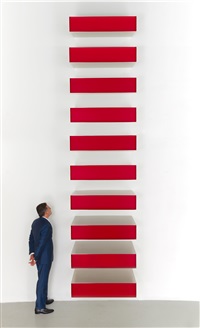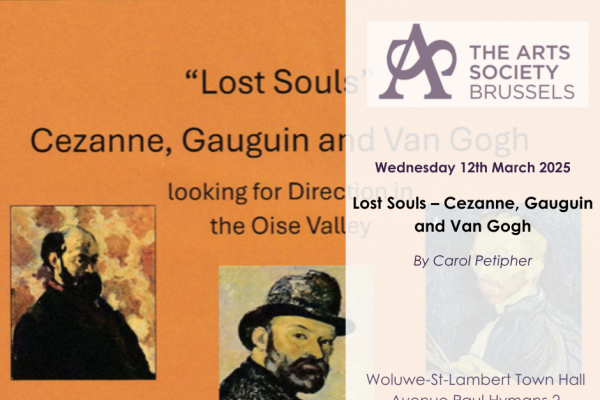
Contemporary art today is at once idolized and murdered. It leaves us seldom indifferent. Yet, many people do not know this art and reject it (too quickly) thereby, they miss an opportunity to still find pleasure, identification or some element of recognition in art, which – as always – is a testimony of our present daily life.
Since 1960, our world has changed at a supersonic pace because of over-consumption, electronics, mass media, globalization, increasing digitalization and an overwhelming image culture. As always, art requires an effort to be understood, moreover so, when it is a result of our present complex society.
This program will show 12 icons of contemporary art from 1960 - 2000, illustrating the major artistic currents: pop art, minimalism, conceptualism, arte povera, neo-expressionism, Düsseldorf Schule für Fotografie, the Young British Artists. Works by established artists such as Andy Warhol, Donald Judd, Bruce Nauman, Giuseppe Penone, Bernd and Hilla Becher, CIndy Herman, Gerhard Richter, Jean-Michel Basquiat, Marlene Dumas, Louise Bourgeois, Andreas Gursky and Damien Hirst are shown and explained.
Note: Content and images not intended for copyright infringement.
“THE ART OF OUR TIME” A Review by Larisa Doctorow On September 10, the art historian Christiane Struyven gave our group a fascinating lecture on the subject, “How to Read Contemporary Art”.
Contemporary art rarely leaves a person indifferent; some idolize it, others hate and reject it. Then what is it? The answer according to our lecturer is that it is a testimony of our time, of our reality, of the world around us. As a focus of her professional interests, Christiane Struyven chose art from the period 1960 to 2000. In her view, it was precisely during this period that the world changed most dramatically, and contemporary art is a reflection of that changed world. Contemporary art, like everything else, takes time and energy to understand. That is true if we see Pompeii frescoes for the first time, or Russian icons or drawing on the walls of Egyptian tombs. But those look more understandable to us, or it seems so. They are figurative. They may have landscapes.
Contemporary art requires a different approach. We heard about the 12 main figures on the art scene of the 20th century, both Europeans and Americans, starting with Andy Warhol and ending with Louise Bourgeois. The speaker gave us a short introduction to the art of each one, leaving us the possibility to continue discoveries on our own. Contemporary art is often very intellectual. Thinking prevails at the expense of the emotions. It is not spontaneous. It lacks naivety, simplicity, joy or fascination of the creator facing the beauty of the world. These 12 gurus were interested in different things and Christiane Struyven illustrated for us their personal approaches.

Contemporary art is not uniform. It varies greatly depending upon the creator, his or her goals. The ‘Marilyn Diptych by Andy Warhol is familiar to everyone. The print is number three in the list of the most popular art works of the 20th century and the most obvious evidence of over-consumption in our modern society.
On the other hand, the sculptures by Donald Judd require a guide to understand what the sculptor wanted to convey. They are purely intellectual. Beauty, attractiveness, feelings are absent. Looking at the rhythm formed by a symmetrical sequence of cubes, you begin to see and understand the meaning of grace in their purity, isolated from reality. My attention was caught by one slide, depicting a column made from the cubes, which resembled a New York skyscraper. The sculptor could not forsake reality completely.

How can we explain the success of contemporary art? Christiane Struyven offered several reasons. For one, the public is tired of hearing about the world’s problems, about wars, poverty, pollution and so on. A lot of contemporary art is pure, not infected with slogans. Looking at the clean lines of the minimalists’ works, you are drawn to calmness. So this art serves as a good psychological tool, which the world needs.
Another reason for this success is financial. Huge amounts of money have accumulated in private hands, and there are not many opportunities to invest. Contemporary art is a good option. The prices are high and keep on growing. At present, 48% of the total sales of art works belong to contemporary art.
Giuseppe Penone represents ‘Arte Povera’, an artistic trend which has appeared as an answer to conceptualism and minimalism. Working primarily with wood, he tries to attract our attention to nature, to the richness of the world. The rise of photography is another feature of our times. Now it occupies a place equal to painting and sculpture, commanding the same level of prices. Two German photographers, Bernd and Hilla Becher, have created a series of images of industrial constructions. Their black and white photos have a special beauty. They attract the public by harmony and rhythm. One could keep on looking at them again and again. At the same time, a German artist from Dresden, Gerhard Richter, creates both figurative and abstract paintings. His huge paintings look as if they are hidden behind a semi-transparent curtain. I guess this is the artist’s tool to hide the painful reality which he conveys on his canvases, such as the Dresden 1944 bombing, or the attempts to escape from the GDR by desperate citizens.
Another politically engaged painter is Marlène Dumas, who did a baby portrait, calling it Hitler. The portrait implies a silent question: how it happened that this cute baby became Adolf Hitler. The art of the American-French sculptor Louise Bourgeois is particularly close to me. Her parents were busy at a tapestry workshop in Paris and watching her mother repairing ancient tapestries she learned to respect work.
Louise Bourgeois looks at the world through a woman’s eyes. She creates works telling about a woman’s universe, such as love, motherhood, sufferings, family. However, everything is presented indirectly as the reflection of the real world and real emotions. That was a novelty for the mid 1960s, when in art the man’s point of view prevailed. Her most famous sculpture is entitled ‘Maman’ and portrays a nine meters high bronze spider. According to Louise Bourgeois, this is the image of a family, because spiders are known for their care of their offspring.

The conclusion from this lecture is that we don’t need diplomas to understand contemporary art. It is sufficient to spend a few minutes looking at it, still better with someone who can explain things. That is why it is the art of our time.



